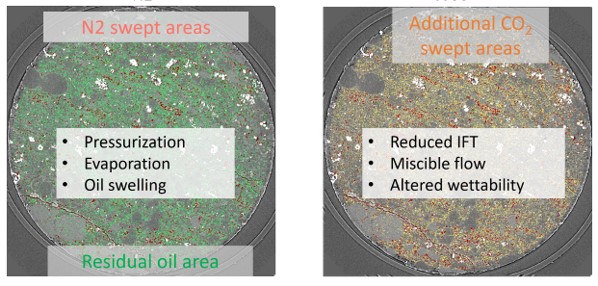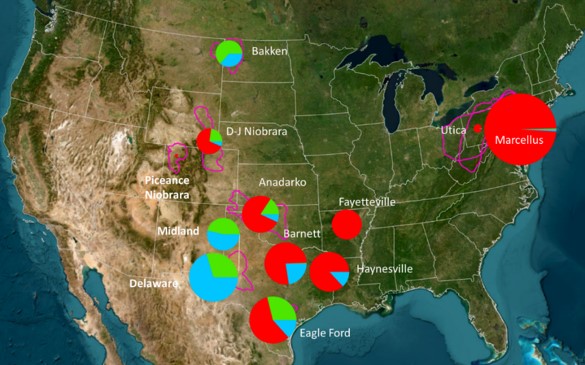
The comparison between nitrogen and CO2 swept areas reveals different recovery mechanisms by the two gases. The superior properties of scCO2 make it more efficient in oil recovery or displacement.
We conducted in-depth investigation of the process and controls of CO2 injection for scCO2/oil miscible displacement for enhanced oil recovery and CO2 storage in shale samples with different wettability. An integrated multiscale imaging and injection under different boundary conditions technique was used. Results of this study filled the knowledge gap on how injected CO2 flows in the shale matrix and how the geological and petrophysical properties, including pore wettability, pore network distribution, connectivity, and heterogeneity, controls the flow. We gained important insights on specific mechanisms of scCO2 oil recovery, the impact of boundary conditions on the CO2/oil displacement, and the effect of heterogeneity of pore wettability on the formation of preferential scCO2 flow paths. These observations and findings have important implications on the challenges and opportunities for optimal engineering design for further enhancement of oil recovery and CO2 storage through CO2 injection in unconventional reservoirs.

Bubble map showing CO2 storage capacity in unconventional reservoirs. Bubble size is proportional to total storage capacity, while the pie slices indicate contribution from different produced liquids (red = gas, green = oil, and blue = water). For basins with no gas contribution indicated, gas was treated as entirely solution gas, rather than free gas at reservoir conditions. From Peng et al., 2023.
Depleted unconventional reservoirs after EOR can also provide a valuable addition to the carbon storage capacities in saline aquifers and depleted conventional reservoirs. The current rate of CO2 storage is only around 56 Megatons (MT), which is far below the global target of ~170 Gigatons (GT) by 2050, requiring storage of 5 – 8 GT per annum to reach net-zero by 2050. As a result, all potential options must be explored. Our recent study indicates a significant storage capacity potential in unconventional reservoirs in the US. Another expected benefit is the ability to reuse existing infrastructure for CO2 injection and monitoring, which can greatly reduce upfront investment costs. We proposed a new injection mode of "huff-and-huff" and a rotational pattern that can be used in many adjacent wells (e.g., 10-100) during the same time window in unconventional reservoirs. This injection pattern can be combined with direct air capture or other transportation methods. Further investigation on the CO2 injectivity, the effect of heterogeneity on CO2-gas, water or oil displacement, CO2 adsorption, and well integrity for CO2 injection is needed for field application and deployment.
Representative publications
Peng, S., P. Shevchenko., P. Periwal, 2024. The Impact of Pore Wettability and Heterogeneity on CO2 Sweeping Efficiency in Enhanced Oil Recovery in Unconventional Reservoir Rocks. Accepted for URTeC 2024.
Peng, S., LMR Maraggi, S. Bhattacharya, K. Yut, T. McMahon, M. Haddad, 2023. Feasibility of CO2 Storage in Depleted Unconventional Oil and Gas Reservoirs: Capacity, Microscale Mechanism, Injectivity, Fault Stability, and Monitoring. Unconventional Resources Technology Conference, June 13-15, Denver, Colorado. (Media coverage by AAPG Explorer and The American Oil & Gas Reporter on this work)